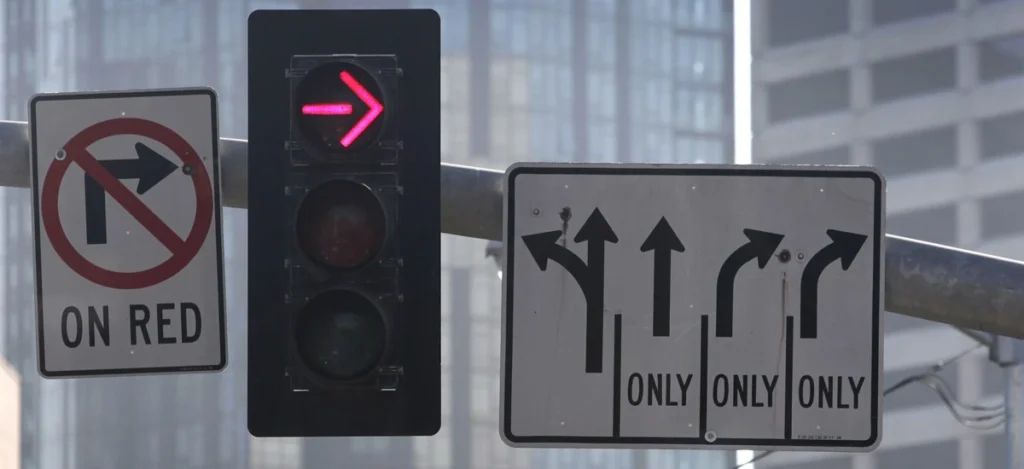The driving maneuver, including the right turn, is often subject to regional traffic regulations, which have implications for traffic safety and efficiency.
This exploration explores the many aspects of turning right on a green light.
This concept allows drivers to make a turn under certain conditions. We examine the various legal issues, situational awareness, and benefits of the maneuver, as well as the importance of making responsible decisions.
The importance of right-turning on a red light
Considerations of law: Traffic laws and regulations:
Permission to turn right on a green light depends heavily on the laws and regulations governing traffic in that jurisdiction. Some regions permit this maneuver in certain circumstances while others restrict or prohibit it. Drivers must understand and adhere to the legal requirements. Understanding the local laws, signs, and rules governing the right turn on red light is essential for responsible and safe driving.
Understanding Restrictions and Exceptions
There are usually specific rules and conditions that must be followed by drivers in areas where it is permissible to turn right at a red light. Some common allowances are the need to yield to traffic coming from the opposite direction, the lack of “no-turn on red” signage, or considerations made for pedestrians at crosswalks. Understanding these conditions allows drivers to navigate intersections with confidence while still adhering to the rules of the right turn at a red signal.
Dynamics of Intersections: Traffic Flow and Strategic Decision-Making
The dynamics of an intersection influence the decision to make a right on a green light. Before making a turn, drivers must consider the traffic flow, pedestrians, and speed of approaching vehicles. Making judicious decisions at intersections can improve traffic flow by reducing delays, and making the process more fluid. Drivers need to be able to understand these dynamics when deciding whether or not they want to turn right on a green light.
Situational awareness: Balance caution and opportunism
When deciding to make a turn at a red signal, situational awareness is crucial. The driver must strike the right balance between being cautious and knowing when to turn. It is essential to be aware of your surroundings. This includes the movements of traffic and pedestrians. The ability of the driver to assess these factors in real-time is crucial to making a responsible right turn at a red traffic light.
Benefits of reducing traffic congestion and improving efficiency
Allowing drivers to make right turns at red lights has its roots in potential traffic benefits. Traffic congestion can be reduced by allowing drivers to turn right when it is safe, including during the red-light phase. The flexibility of traffic management leads to a smoother flow of traffic, reduced delays, and improved intersection efficiency. Benefits can be extended beyond drivers and to the wider community. This creates a dynamic, responsive traffic system.

Pedestrian safety considerations: Balancing movement with pedestrian right-of-way
Drivers must always be aware that pedestrians have the right of way, even though it is convenient to make a turn at a red signal. Drivers must always yield to pedestrians at crosswalks. To make a responsible decision, drivers must carefully assess pedestrian movement, communicate clearly through the use of turn signals, and know when it’s safe to turn. To make a right turn at a red light, pedestrians must be kept safe.
Education Initiatives Promoting awareness and responsible driving
Due to the potential complexity and nuances associated with turning right on a green light, education initiatives are crucial in raising awareness amongst drivers. A comprehensive driver’s education program should cover the legal implications, considerations of situations, and making responsible decisions associated with such a maneuver. Well-informed drivers can navigate intersections with confidence and responsibility, which contributes to overall road safety and efficiency.
Contributions to Technology: Advanced Driver Assistance Systems
Driver assistance systems are a vital part of safe driving in the modern age of technology. This includes the ability to make a right turn at a red light. Driver assistance systems (DAS) include features such as collision avoidance and blind spot detection that enhance the driver’s awareness. The technology aids give drivers real-time data about possible hazards. This allows them to make an informed decision at critical times, such as when they are contemplating turning right on a green light.
Changing Attitudes towards the Manoeuvre
Public perception is also important in determining whether or not the right-turn concept will be accepted and adhered to. Public awareness campaigns and legal clarification are important in shaping positive attitudes toward this maneuver. Encouraging drivers to see the maneuver as an important tool to improve traffic flow while highlighting the importance of safe and responsible behavior can help to increase acceptance and compliance.
Summary: A dynamic traffic strategy: right-turn on a red light
Making a right on a red signal is an effective traffic strategy. It requires a thorough understanding of the law, awareness of your surroundings, and making responsible decisions. This maneuver is important in traffic management because of its potential benefits such as less congestion and better traffic flow. While drivers negotiate intersections, their ability to balance caution and opportunism while prioritizing pedestrian safety is crucial. The right turn on a red light will continue to evolve with the help of technological advances and education initiatives. This is paving the way for a responsible, efficient, and informed approach to urban mobility.
